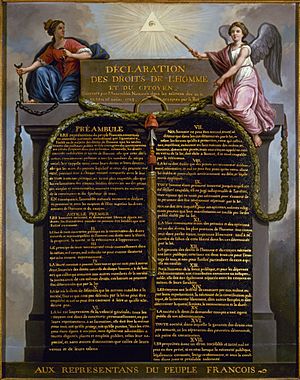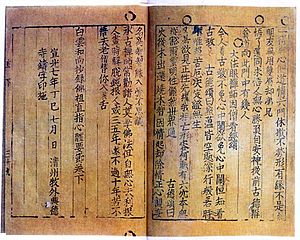Memory of the World Programme facts for kids

The Memory of the World Programme is a special project by the United Nations Educational, Scientific and Cultural Organization. It helps protect important historical documents and records from around the world. This program focuses on valuable items found in archives and libraries. UNESCO started this program in 1992 to make sure these historical treasures are kept safe for future generations.
Contents
What is the Memory of the World Programme?
This program works to find, preserve, and share the world's most important documents and collections. Think of it like a global treasure hunt for knowledge! It helps countries protect their unique history and culture. The goal is to prevent the loss of valuable records, like old books, maps, films, and sound recordings.
Why is it important to save old documents?
Saving old documents and records is super important because they tell us about the past. They show us how people lived, what they believed, and how societies changed over time. These records are like clues that help us understand history, learn from it, and build a better future. Without them, parts of our shared human story could be lost forever.
Who manages the program?
A group called the International Advisory Committee (IAC) runs the Memory of the World Programme. This committee has 14 members. Each member is chosen by the head of UNESCO. They meet regularly to decide which new documents should be added to the World Register.
What is the Memory of the World Register?
The Memory of the World Register is a list of the most important and unique documents and collections from all over the world. These items are chosen because they have special meaning for human history. The IAC committee picks new additions to this list every two years.
Examples of items on the Register:
- Bayeux Tapestry: A famous embroidered cloth from the 11th century that tells the story of the Norman conquest of England.
- Magna Carta: A very old English document from 1215 that limited the power of the king and influenced many laws around the world.
- The Diary of a Young Girl: The famous diary written by Anne Frank during World War II.
- Beethoven's Symphony No. 9: The original manuscript of this famous piece of music.
- Jikji: The earliest known book printed with movable metal type.
- Treaty of Tordesillas: A treaty from 1494 that divided the newly discovered lands outside Europe between Portugal and Spain.
What is the Jikji Prize?

The Jikji Prize is an award given to people or groups who do great work in preserving important documents. It was created with help from the South Korean government. The prize includes $30,000 and covers all related costs. It encourages more people to get involved in protecting our shared heritage.
Who has won the Jikji Prize?
- 2005: Czech National Library in Prague.
- 2007: Austrian Academy of Sciences, Phonogrammarchiv in Vienna.
- 2009: National Archives of Malaysia in Kuala Lumpur.
- 2011: National Archives of Australia in Canberra.
See also
In Spanish: Programa Memoria del Mundo para niños

